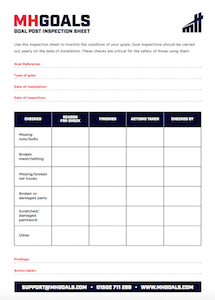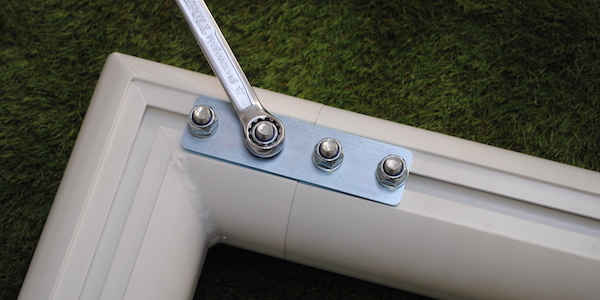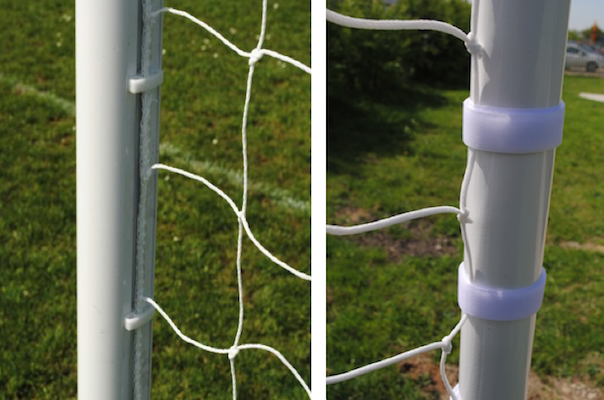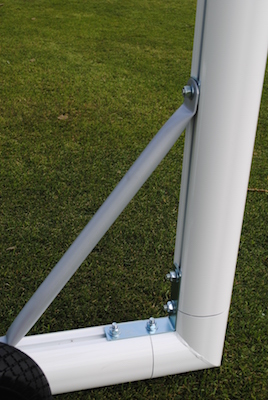With winter now upon us, bringing with it shorter days and colder weather, it can be easy to cut corners when doing a goalpost safety check. However just spending a few moments more on the set up and maintenance of your equipment will help prevent injury and prolong the life of your goals.
Download a printable copy of this guide here
Goal post safety is paramount to MH Goals, and all equipment manufactured by us conforms to the latest British and European safety standards. What’s more, our MD Mark Harrod is one of the UK’s leading experts on goal post safety, design and manufacturing, and is recognised as an independent expert by the British Standards institute (BSI) where he consults on both British and European sports equipment safety standards. In light of this Mark has offered tips and advice on maintaining your goals that will serve you all year round.
Check bolts are tightened and securely fastened
Loose nuts and bolts can cause a number of issues. The goal will become unstable, pieces will fall off while in play, and there will be increasing wear and tear on other parts. This is a simple fix as many goals use the same size parts, so a quick turn with a 17mm or 13mm spanner can eliminate many future problems.
Should any parts be missing it is vital that the goals are not used until the required repairs have been made.
Replace any net hooks that have gone missing or have broken
Nets that are not properly fastened to the goals not only look untidy but can cause a real safety issue with an increased chance of players becoming tangled in the net. If the goals are aluminium they will most likely use an enclosed hook that slots into the moulded channel of the goal. With steel and plastic goals that don’t have this channel, Velcro or cable ties can be used to secure the nets to the posts.
Check corners for cracks or the aluminium splitting
Aluminium that has been simply cut or mitred tends to separate, leaving sharp exposed corners. It’s important if you have this type of goal to regularly check they are still safe to use, as they can cause serious injuries. Goals with welded corners don’t have this issue as the edge is covered by a smooth weld; however it is still important to check these as misuse or old age can cause the aluminium to crack.
Check wheel mechanisms
The wheels on any football goal tend to take a lot of abuse but there are a few things that can be done to keep them in good working order. Greasing the moving parts will keep the wheels running smoothly and reduce wear on all parts.
As with the goal frames, you should check that the nuts and bolts are tightened to keep the wheels tight and in line to prolong their life. Lowering the wheels when not in use takes the weight off the moving parts and reduces the risk of damage.

Make sure weights are attached and correct amount being used
Every goal manufactured by MH Goals is tested to conform to the latest British and European safety standard, but this is only applicable when the goal is properly anchored. There are a few ways in which goals are anchored, including handbag weights, sand bag weights, U peg anchors, chains and internal weights.
Handbag weights can be chained to the corner of the goal to make it safe, but it’s important to check that the right amount are being used – six per goal for 24×8 and 21×7 goals and four per goal for 16×7, mini soccer and 5 a side goals. Sand bags are an easy way to add weight, and as they are flexible they can easily be placed over the back bar. We recommend three sandbags for a 24×8 or a 21×7 goal, and for 16×7 mini soccer and 5 a side goals two sand bags can be used. U peg anchors can be simply knocked over the back bar into the pitch but remember to check the conditions; a U peg anchor will not be as effective on a waterlogged pitch as it would on a dry one. If this is the case use handbag weights or sand bags to make the goal safe. If the goals have been chained to a fence or suitable post make sure that both the chain and carbine clip are in good condition and suitable for the job of anchoring your goal. We also make a range of self-weighted goals where the weight is housed inside the aluminium, removing the need for any external anchorage.
Label each goal for easy identification
Often clubs will have portable goals that are moved before and after each match, so labelling each goal will enable the user to easily identify the goals for maintenance purposes. This then simplifies the task of reporting faults, getting new parts and making the necessary repairs.
Fill out a maintenance sheet
Much like a car service history, goal maintenance sheets give the user a clear background into what has been done to a goal to keep it serviceable and safe. By regularly maintaining your goals it will also highlight issues before they become serious and make the goals unusable or dangerous.
The current recommendation is that all records relating to the goal should be kept for a minimum of 21 years to ensure that evidence of good practice is available in the event of any subsequent legal proceedings. Click the link below to find our maintenance sheet that you can print off and use for your goals.

Check nets for holes or damage
Larges holes can appear in the nets for a number of reasons, from general wear and tear to vandalism or rodent damage. The net mesh size of a football goal is in fact governed by both British and European safety standards to reduce the risk of head and limb entrapment, so should the mesh become damaged, nets have the potential to cause serious injury. If only one or two meshes have been damaged you can use a length of twine to patch the net up, but if the damage has produced a large hole the only option is to purchase a new net.
If as a result of your checks you find any failings, we stock a huge range of replacement parts. Follow this link to see them all, or give us a call on 01502 711298 to discuss your needs.




